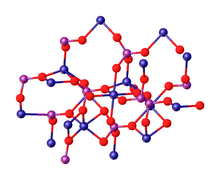
| |

| |
| Names | |
|---|---|
| Other names
cobalt violet, cobalt(II) phosphate, cobalt orthophosphate, Pigment Violet 14
| |
| Identifiers | |
3D model (JSmol)
|
|
| ChemSpider | |
| ECHA InfoCard | 100.033.309 |
| EC Number |
|
PubChem CID
|
|
| UNII | |
CompTox Dashboard (EPA)
|
|
| |
| |
| Properties | |
| Co3(PO4)2 | |
| Molar mass | 366.74231 g/mol |
| Appearance | violet solid |
| Density | 3.81 g/cm3 |
| Melting point | 1,160 °C (2,120 °F; 1,430 K) |
| insoluble | |
Solubility product (Ksp)
|
2.05×10−35[1] |
| 28,110.0·10−6 cm3/mol | |
Refractive index (nD)
|
1.7 |
Except where otherwise noted, data are given for materials in their standard state (at 25 °C [77 °F], 100 kPa).
| |
Cobalt phosphate is the inorganic compound with the formula Co3(PO4)2. It is a commercial inorganic pigment known as cobalt violet.[2] Thin films of this material are water oxidation catalysts.[3]

A swatch of cobalt violet, popular among the French impressionists.
- ^ John Rumble (June 18, 2018). CRC Handbook of Chemistry and Physics (99th ed.). CRC Press. pp. 5–188. ISBN 978-1138561632.
- ^ Hugo Müller, Wolfgang Müller, Manfred Wehner, Heike Liewald "Artists' Colors" in Ullmann's Encyclopedia of Industrial Chemistry 2002, Wiley-VCH, Weinheim. doi:10.1002/14356007.a03_143.pub2
- ^ Matthew W. Kanan; Yogesh Surendranatha; Daniel G. Nocera (2009). "Cobalt–phosphate oxygen-evolving Compound". Chem. Soc. Rev. 38 (1): 109–114. doi:10.1039/B802885K. PMID 19088970.
